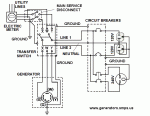Don, in the event of a power outage you "Back Feed" power into the panel?
Do I understand this to mean that you have power flow from the generator through a regular outlet on the wall somewhere so that all the circuits in your workshop, or house have power?
If that is true, I sure hope you turn the main breaker off at the service, so that your house is isolated from the grid completely, because if you don't do that, some lineman up on a boom truck fixing the problem could get killed. There are also some other issues dealing with how the one outlet is hooked up to the panel and how the 240v from the generator gets fed in and becomes 120v etc.
If it was me, I'd just use extension cords, or I'd spend the money and get a transfer switch installed.
FYI





